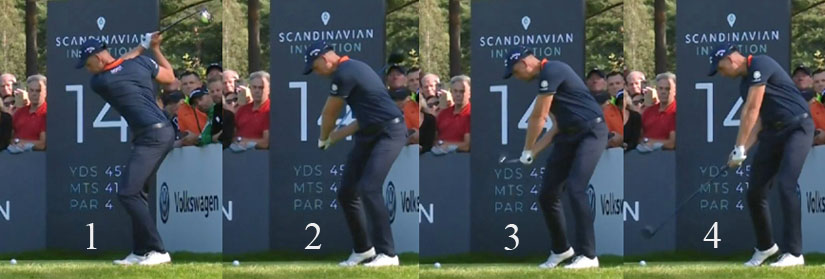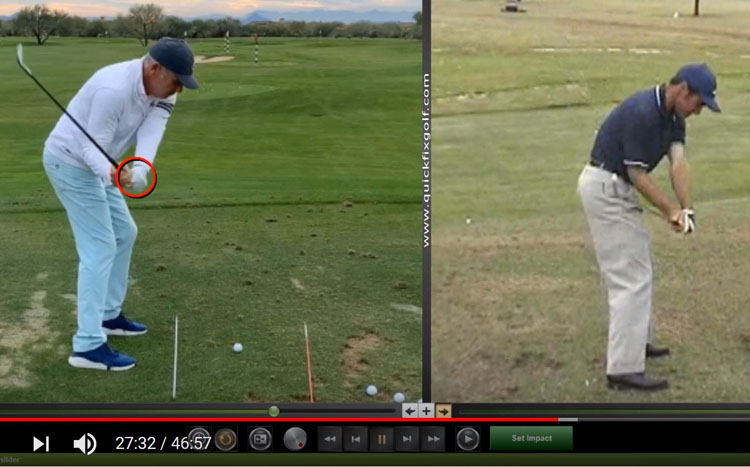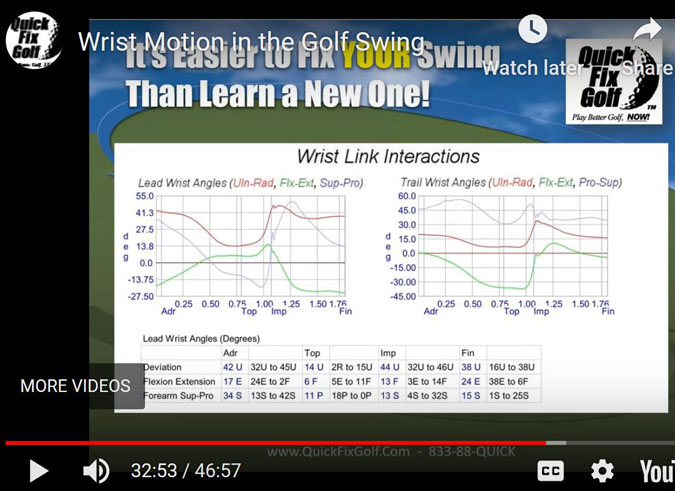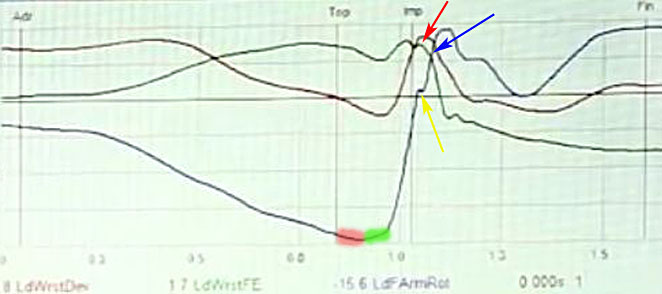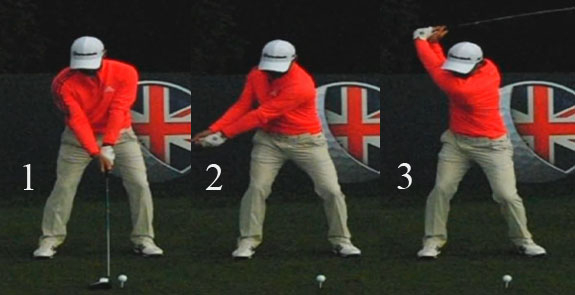|
|
Post by imperfectgolfer on Jun 26, 2020 17:34:58 GMT -5
See this video featuring Eric Cogorno and Milo Lines. Note that they both recommend bowing the left wrist at the very start of the downswing while maximally extending the right wrist. Milo even claimed that many pro golfers manifest this pattern. I got into a back-and-forth argument/counterargument with Milo - see comment section of the video. I eventually met Milo in person a day ago where I had the opportunity to ask him why he would recommend palmar flexing the left wrist at the very start of the downswing. I thought that he would argue that it would increase his clubface closure during the early downswing - as Tyler Ferrell claims for his reverse motorcycle move - but Milo was not even aware of the existence of the reverse motorcycle move. His only argument was that if it happens in the early downswing, that it would allow him to maximally extend his right wrist, which would allow the club to angle back to a slightly greater degree. He claimed that it would allow him to have more time to release his club. I personally do not think that the small increase in lag, where the club may be simultaneously angled back slightly more in an underplane manner, is significant, and I do not personally know of any pro golfer who actually increases their degree of left wrist palmar flexion between P4 => P5. In fact, in the comment section of their video, I showed that Jon Rahm, who already has a bowed left wrist at P4, actually decreases his left wrist bowing between P4 => P5, before increasing it again between P5 => P6 as a result of using the combined "early left forearm supination + increased left wrist bowing" maneuver after P5. Although I personally favor the intact LAFW swing technique as used by Henrik Stenson and Justin Rose, I think that it is perfectly acceptable to use a bowed left wrist technique (like Gary Woodland or Dustin Johnson or Jordan Spieth or Jon Rahm) and I could imagine that it may potentially give a golfer more left wrist stability through impact if one uses a DH-hand release action. However, I know of no other benefit to using a bowed left wrist technique. If you know of another potential benefit - please let me know.
By the way, if anybody has a 3-D graph showing increased left wrist flexion between P4 => P5, please post that graph.
Jeff.
p.s. I though that I had seen a 3-D graph of Jamie Sadlowksi's left wrist flexion-extension angles in this golf forum, but I cannot locate it. Help!
|
|
|
|
Post by dubiousgolfer on Jun 26, 2020 20:03:29 GMT -5
Dr Mann There are quite a few wrist flexion graphs in this link below jeffygolf.com/showthread.php?775-What-s-wrong-with-this-pictureWooodland (ie. Elite golfer)
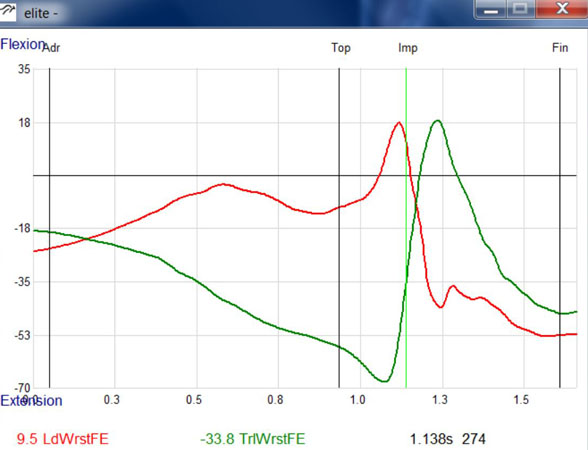
Elkington 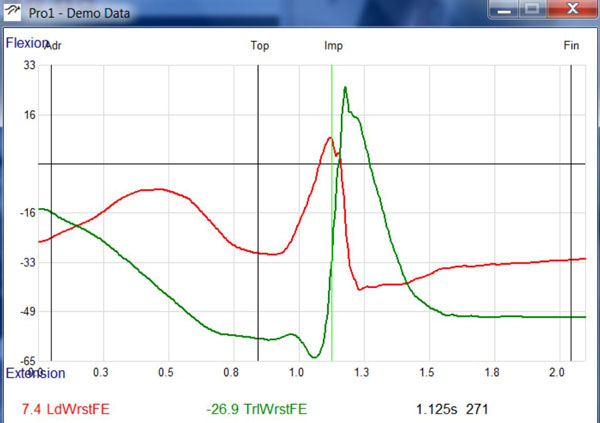
Els
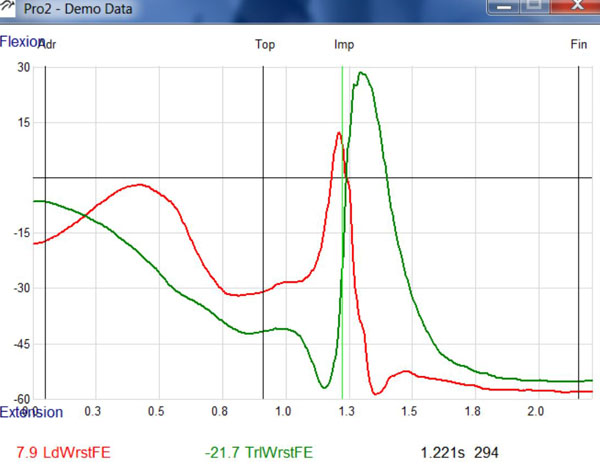 I'll search for JS's graph as I remember posting it on some previous thread. DG
Addendum by ImperfectGolfer (Moderator) - I copied the images from Jeffy's folder and moved them to my website, so that they would be visible in this post. I removed Aaron Oberholzer's graph because he uses an ultra-strong left hand grip.
|
|
|
|
Post by dubiousgolfer on Jun 26, 2020 20:11:12 GMT -5
JS's 3D graph for left wrist flexion-extension is in this link below. 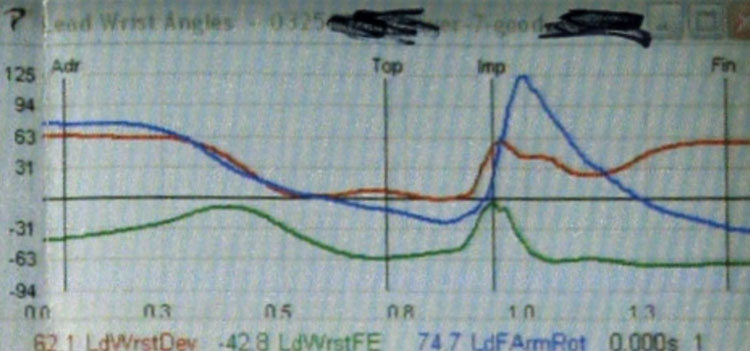 DG |
|
|
|
Post by imperfectgolfer on Jun 26, 2020 21:04:34 GMT -5
DG,
Thanks for posting 3D graphs of Woodland, Elkington, and Els.
They generally show no evidence of left wrist bowing in the early downswing between P4 => P5, and they show the familiar pattern of left wrist palmar flexion happening later in the downswing as the left wrist moves towards ulnar deviation.
Jamie Sadlowski also shows no increased left wrist flexion happening in the early downswing, and his left wrist only becomes less extended near impact as it moves towards ulnar deviation.
Jeff.
|
|
|
|
Post by utahgolfer on Jun 27, 2020 11:42:37 GMT -5
 Jeff, Isn't GW doing what you suggest most pros generally don't do? Wouldn't it be just as important to highlight what an elite player does than to make a generalization based on group data? I think individual and group evidence can be important, but not at the exclusion of the other. Most importantly, is there any advantage or disadvantage to palmar flexing the lead wrist before p4, at p4, at p5, or p6? Isn't it simply a personal preference, as illustrated by GW? UG |
|
|
|
Post by imperfectgolfer on Jun 27, 2020 19:15:11 GMT -5
 Jeff, Isn't GW doing what you suggest most pros generally don't do? Wouldn't it be just as important to highlight what an elite player does than to make a generalization based on group data? I think individual and group evidence can be important, but not at the exclusion of the other. Most importantly, is there any advantage or disadvantage to palmar flexing the lead wrist before p4, at p4, at p5, or p6? Isn't it simply a personal preference, as illustrated by GW? UG What Gary Woodland is doing differently to Ernie Els and Steven Elkington is that he is starting to palmar flex his left wrist earlier due to his use of an "early left forearm supination + left wrist palmar flexion" maneuver. In his 3D graph, it would seem that GW's left wrist is starting to palmar flex from the start of the downswing, but the slope of his left wrist flexion graph is not steep between P4 => P5 and he only really starts to initiate his combined "early left forearm supination + left wrist flexion" maneuver after P5, and not between P4 => P5. That can be seen in the following capture images of GW's early-mid downswing action. Image 1 is at P4, image 2 is at P5, image 3 is at P5.5 and image 4 is at P6. Note that he has a GFLW at P4 and that there is no obvious left wrist bowing at P5. Note that his left wrist bowing starts after P5 and is readily visible by P5.5. Note that his left forearm is pronated at P5 and it starts supinating after P5 as he initiates his combined "early left forearm supination + left wrist bowing" maneuver. That delay in his combined "early left forearm supination + left wrist bowing" maneuver so that it only happens after P5 can also be seen in his 3D graph below. Note that GW pronates his left forearm in his early downswing and he only starts his left forearm supination after P5 - at the same time as his left wrist flexion graph starts to steepen. I have no objection to the use of a combined "early left forearm supination + left wrist bowing" maneuver golf swing technique that starts after P5 - as an alternative swing technique to the intact LAFW/GFLW technique. I have only questioned Eric/Milo's opinion that it should start earlier than P5 (= between P4 and P5). What value would be gained by significantly bowing the left wrist + significantly extending the right wrist between P4 => P5? There are some pro golfers who bow their left wrist during their backswing (eg. Jordan Spieth, Jon Rahm and Dustin Johnson) but they do not increase their left wrist bowing, or increase their right wrist extension, between P4 => P5 as Milo recommends. What would be the advantage of such a maneuver? Jeff.
|
|
|
|
Post by utahgolfer on Jun 28, 2020 9:22:15 GMT -5
Jeff, in looking at this graph of GW it appears to show that left wrist palmar flexion (green line) begins to reverse itself well before p4. It is true that the rate of increased rate of palmar flexion increases significantly at p5, but GW clearly begins to move in the direction of more left wrist palmar flexion well before p4. 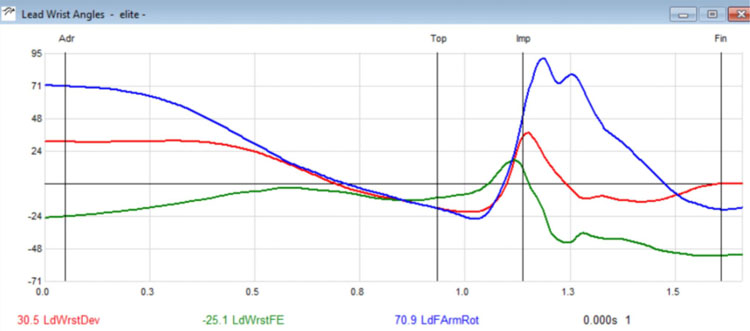 The relative position of the wrist, whether more toward radial deviation or ulnar deviation, may explain why we see the differences in the amount of palmar flexion from p3.5 to p5.5. It probably has nothing to do with what is more advantageous swing-wise. As the player maintains more left wrist radial deviation (p3.5 to p5) there will normally be less palmar flexion because of the inherent wrist structure (with more radial deviation, the wrist can't do as much palmar flexion; with less radial deviation, the wrist can do more palmar flexion). Since the left wrist normally begins to unhinge or ulnar deviate after p5, this would explain why we see most left wrist palmar flexion happen here. It comes down to a wrist position that favors more palmar flexion; and doesn't appear to be related to any biomechanical swing advantage. However, some player, due to greater wrist mobility, may exhibit the ability to palmar flex the left wrist more at a given left wrist radial deviation angle, as is the case with GW and other players. Because it appears to be a functional anatomical phenomenon, it makes the most sense to instruct players to "try" to palmar flex the left wrist from the beginning of the downswing. The force input to elicit palmar flexion would result in little actual palmar flexion for most players, but they would be activating the muscles to make it happen once the wrist conditions (more ulnar deviation) allows for it. The downswing happens so quickly, it makes little sense to "wait" until p5 to activate the muscles necessary to perform left wrist palmar flexion. It makes more sense to instruct players to palmar flex from p4 and then allow the changes in wrist position (the increased ulnar deviation) to dictate when and how much palmar flexion can be achieved from p4 to p6.5. On the other hand, a player shouldn't prematurely unhinge the wrists (with more left wrist ulnar deviation) from p4 to p5, just so he or she can perform more actual left wrist palmar flexion during this time. UG |
|
|
|
Post by imperfectgolfer on Jun 28, 2020 12:04:53 GMT -5
UG, You wrote-: " Because it appears to be a functional anatomical phenomenon, it makes the most sense to instruct players to "try" to palmar flex the left wrist from the beginning of the downswing. The force input to elicit palmar flexion would result in little actual palmar flexion for most players, but they would be activating the muscles to make it happen once the wrist conditions (more ulnar deviation) allows for it. The downswing happens so quickly, it makes little sense to "wait" until p5 to activate the muscles necessary to perform left wrist palmar flexion." What muscles do you envisage being activated to cause left wrist palmar flexion between P4 => P5?
I personally do not favor trying to actively contract the left wrist flexor muscles to induce left wrist flexion, and I think that any increased palmar flexion of the left wrist during the early downswing should be a side-effect of an active right arm adduction maneuver using a pitch elbow motion where the right elbow leads the right hand. That active right arm adduction maneuver can shallow the clubshaft and that may secondarily cause increased left wrist palmar flexion and increased right wrist extension.
Here is Henrik Stenson's downswing action. Note that he has an intact LAFW at P4 (image 1). His left wrist alignment must therefore be a GFLW even though it is overtly dorsiflexed.
Note that he has shallowed the clubshaft by P5.5 (image 2) and he no longer has an intact LAFW, but he still has an intact LFFW. That means that he must still have a GFLW - even though his left wrist is far less dorsiflexed at P5.5 compared to P4. So, his left wrist is passively moving towards flexion and I do not believe that it is due to active contraction of his left wrist flexor muscles. Now, it is possible to get to the P5.5 position with a greater degree of left wrist palmar flexion if one uses a "combined early left forearm supination + increased left wrist flexion" manneuver (like Gary Woodland) and that will angle the clubshasft slightly more in an underplane direction. However, I know of no advantage to Gary Woodland's technique relative to Henrik Stenson's technique. Here is a link to a video featuring Jon Sinclair.
Jon Sinclair claims that the advantage of flexing the left wrist early between P4 and P5 is that it closes the clubface earlier (which is not what Milo claims). I disagree that left wrist palmar flexion closes the clubface earlier (relative to the clubhead arc) in the absence of a reverse motorcycle maneuver. As an example, Jon Sinclair compares Trevor Immelman to an amateur golfer - watch the video starting at the 23:40 minute time point. At the 24:48 minute time point, Jon Sinclair points out how TI's clubhead moves down-and-back behind him and he claims that this clubshaft shallowing move is a clubface-closing manuver. I disagree! Note that Trevor's clubface is not closing more relative to his clubhead arc between P4 => P5.
Here is a capture image from his video - at the 27:32 minute time point. Note that the amateur golfer (on the left) has a cupped left wrist. Jon Sinclair claims that his clubface is too wide open and that he is going to have trouble squaring the clubface by impact. That's BS! I think that TI's clubface is in the same open clubface position (relative to the clubhead arc and relative to the watchface area of the left lower forearm) and they both should have no problem squaring the clubface by impact by using a PA#3 release action.
At the 26:44 minute time point of the video, Jon Sinclair claims "that as long as the left wrist is moving towards flexion you are closing the clubface". I disagree! Henrik Stenson's left wrist is moving towards left wrist flexion between P4 => P5.5, but his clubface is not closing relative to his clubhead arc. Note that HS's left wrist is moving towards flexion at P5.5, but his clubface is not closing more relative to the clubhead arc. Note that his clubface is still roughly straight-line-aligned with the watchface area of his left lower forearm. Note that HS still has to use the standard amount of left forearm supination during his PA#3 release action that is happening between P6.5 and impact. Jeff.
|
|
|
|
Post by dubiousgolfer on Jun 29, 2020 8:34:24 GMT -5
Dr Mann
I found that Jon Sinclair video quite confusing but its obvious where Dan Carraher got his argument from regarding 'rapid ' extension of the lead wrist into/through impact.
I did find his interpretation of those graphs from 30:00 onwards difficult to understand, especially when he mentions that "both of those arms into impact are supinating" (from 32:00 - 33:11).
I thought the trail wrist graph is showing 'Pronation' in the positive y-axis, while the lead wrist graph is showing supination in the positive y-axis. Have I misinterpreted something?
DG
PS. Strange that Jon Sinclair guessed that the graphs were John Rahm but one of the other presenters said 'Daniel Burger' .
|
|
|
|
Post by imperfectgolfer on Jun 29, 2020 9:49:37 GMT -5
Dr Mann I found that Jon Sinclair video quite confusing but its obvious where Dan Carraher got his argument from regarding 'rapid ' extension of the lead wrist into/through impact. I did find his interpretation of those graphs from 30:00 onwards difficult to understand, especially when he mentions that "both of those arms into impact are supinating" (from 32:00 - 33:11). I thought the trail wrist graph is showing 'Pronation' in the positive y-axis, while the lead wrist graph is showing supination in the positive y-axis. Have I misinterpreted something? DG PS. Strange that Jon Sinclair guessed that the graphs were John Rahm but one of the other presenters said 'Daniel Burger' . Here is the graph from the Jon Sinclair video. Both the left forearm and right forearm graphs are showing supination in the positive Y axis. The right hand supination graph shows an abrupt switch to far less supination in the late downswing when PA#3 releases. It happens quite late in that golfer's late downswing action. It looks like his right forearm is 30 degrees supinated at P4, then about 50 degrees supinated at P6 before becoming far less supinated (~ 35 degrees) by impact. Also, the right forearm supinates from 30 degrees at P4 to 50 degrees at P6 and during that right forearm supinatory time period (which is presumably due a pitch elbow motion associated with clubshaft shallowing) the left forearm is pronating. I think that Jon Sinclair is wrong to claim that the left forearm supination graph shows continued massive left forearm supination through impact. Note that the left forearm supination graph has a small plateau (small hitch) just after impact (probably between P7 and P7.2) where left forearm supination temporarily stops, and note that the slope of the left forearm supination graph is far less steep after P7.2 (compared to the pre-impact PA#3 release time period). Note that there is also a small plateau (small hitch) in the left wrist flexion graph between P7 and P7.2 and the left wrist is not massively extending during that short time period.
Here is Jon Rahm's 3D graph. Note that the yellow arrow is pointing at a temporary plateau in the left forearm supination graph. I don't think that the graph in the Jon Sinclair video is Jon Rahm's 3D graph. Note that in this 3D graph, the left forearm is pronated at address and just below the zero line at impact (= less pronated) - while the left forearm is markedly supinated at address in the Jon Sinclair graph. I also don't think that it represents Daniel Berger's 3D graph because he uses a very strong left hand grip and he should not have so much left forearm supination happening during his PA#3 release action.
Note that there is also a plateau in his left wrist flexion graph between P7 => P7.2 - see red arrow - showing that Jon Rahm does not massively extend his left wrist between P7 => P7.2+. Jeff.
|
|
|
|
Post by dubiousgolfer on Jun 29, 2020 10:41:00 GMT -5
Dr Mann - many thanks .
The reason I thought that the trail wrist graph was showing 'Pronation' in the positive y-axis is the way the graph is labelled . The left graph says "Sup-Pro" , while the right graph says "Pro-Sup".
DG
|
|
|
|
Post by imperfectgolfer on Jun 29, 2020 12:37:22 GMT -5
I think that I have solved the "mystery" as to who is the pro golfer responsible for the following 3D graph featured in the Jon Sinclair video. To solve the "mystery", I had to find a pro golfer who manifests all of the following biomechanical elements. 1) A left wrist that is extended at address, but then becomes slightly flexed in the later backswing. 2) A left wrist that is slightly flexed at P4, and then remains slightly flexed to the same degree between P4 => P6 (without increasing the degree of flexion) before becoming more flexed between P6 and P6.9 (just before impact). 3) A left wrist that is still slightly flexed at impact and remains slightly flexed to the same degree between P7 and P7.2, before increasingly moving towards extension after P7.2. (= DH-hand release pattern). 4) A left forearm that is supinated at address, and pronated to a small degree at P4. 5) A left forearm that becomes increasingly pronated between P4 => P6.
6) A left forearm that rapidly supinates between P6.5 => impact as a result of a PA#3 release action and where the magnitude of the left forearm supination phenomenon suggests a neutral left hand grip pattern. 7) A left forearm that temporarily stops supinating between P7 => P7.2 before supinating again after P7.2. 8) A right forearm that is supinated at address, that becomes increasingly supinated during the takeaway and that then becomes less supinated between P2 => P4. 9) A right forearm that supinates more between P4 => P6, and that remains constantly supinated to roughly the same degree (in a plateau manner) between P6 => P6.7 before becoming slightly less supinated between P6.7 => P7. 10) A right wrist that is extended at P4, but does not become more extended between P4 => P6. 11) A right wrist that is extended at P6, but becomes neutral by P7 as a result of a right wrist straightening phenomenon.
Those multiple required biomechanical elements resulted in a lot of swing analysis detective work on my part, but I think that I have solved the "mystery" as to the potential identity of the "mystery" pro golfer. I think that the "mystery" pro golfer is Trevor Immelman. Here is a face-on swing video of Trevor's driver swing. Here are capture images of his address and backswing action. Image 1 is at address, image 2 is at P2 and image 3 is at P4. Note that he has a neutral left hand grip. Note that his left wrist is slightly extended at address.
Note that his left forearm is supinated at address because his left humerus is internally rotated at address (where the left antecubital fossa faces away from the target). Note that his right forearm is supinated at address, but his right wrist is neutral. During his takeaway, he moves his left wrist towards flexion while he pronates his left forearm. His right wrist increasingly extends and his right forearm increasingly supinates. Between P2 => P4, his left forearm increasingly pronates and his left wrist becomes very slightly palmar flexed by P3.5 before remaining slightly flexed to the same degree between P3.5 => P4. His right wrist increasingly extends between P2 => P4, but his right forearm becomes less supinated between P2 => P4. Here are capture images of his downswing action. Image 1 is at P5, image 2 is at P6, image 3 is at P6.5, image 4 is at impact and image 5 is at P7.2. His left wrist (which was slightly flexed at P4) remains slightly flexed to roughly the same degree between P4 => P6.
His left wrist becomes increasingly flexed between P6 => impact.
His left forearm pronates between P4 => P6 when he shallows his clubshaft.
His left forearm only supinates to a small degree between P6 => P6.5, and then rapidly supinates between P6.5 => P7.
His left wrist remains slightly flexed to the same degree between P7 => P7.2, and it does not rapidly extend through impact (which allows him to be a DHer). His left forearm temporarily stops supinating through impact, which allows him to execute a DH-hand release action where the clubshaft does not bypass his left arm at P7.2. His right wrist (which was extended at P4) does not increase its degree of extension between P4 => P6. His right wrist straightens between P6 => P7 and it becomes neutral by impact.
His right forearm increasingly supinates between P4 => P6 when he performs an active right arm adduction manuever combined with a pitch elbow motion of his right elbow.
His degree of right forearm supination does not change much between P6 and impact in a pronatory direction, and it only becomes slightly less supinated through impact (between P7 => P7.2 - see the small hitch in his right forearm supinatory graph between P7 => P7.2). His right forearm is less supinated at P7.2 compared to P6 because his right forearm is moving in a pronatory direction between P6 => P7.2 (by about 15 degrees according to that 3D graph) but it never becomes frankly pronated during his late downswing action. Jeff.
|
|
|
|
Post by utahgolfer on Jun 29, 2020 14:00:55 GMT -5
Jeff, thanks for your insights.
You said earlier: Although I personally favor the intact LAFW swing technique as used by Henrik Stenson and Justin Rose, I think that it is perfectly acceptable to use a bowed left wrist technique (like Gary Woodland or Dustin Johnson or Jordan Spieth or Jon Rahm) and I could imagine that it may potentially give a golfer more left wrist stability through impact if one uses a DH-hand release action. However, I know of no other benefit to using a bowed left wrist technique. If you know of another potential benefit - please let me know.
I'm not sure what you mean by saying "I personally favor" the intact LAFW swing technique. Since a number of pros use the bowed left wrist technique with success, how can you say the LAFW method is "personally favored?" It is easy to see why the flip-roll release technique is not preferred or successful, but not the bowed left wrist technique. Obviously, Stenson and those who use a LAFW technique, have been no more or less successful than those who use a bowed left wrist technique. It could also be true that if these players switched techniques, they would play worse (and this is why they use a particular method). So, it becomes a personal preference of the player based on his or her success, irrespective of which method is called more advantageous or favorable.
On this topic, it is relevant to ask if players like Phil and Luke who perform a flip-roll release do it because this is the best their given body structure and function can do. Have players like Phil and Luke truly evolved to the best technique for them based on their individual characteristics? What if these players simply needed better coaching and a better understanding of the golf swing. Milo Lines mentioned that Luke Donald has a poor body rotation, has tried to change his release pattern, and couldn't do it. This might be true, but I think Luke should hire Milo and see if this is correct. I would be very surprised if LD doesn't have the innate ability to rotate his body correctly and perform a drive-hold release, with consistency and success. How can a gifted player like LD not have the ability to perform these basic swing elements? It is possible, but hard to believe.
I agree that a bowed left wrist stabilizes the hand/wrist complex. A more stable linkage will transmit force through it more efficiently, with less energy loss through unstable wrist/hand micro-motion. Another benefit of the bowed left wrist method is that it might help the player drive-hold more easily with the shaft not passing the hands through the impact zone. A third benefit, is that the bowed left wrist method angles the club shaft more behind the player during the downswing (whenever it happens) and this gives the player more absolute time to square the clubface and adjust clubhead speed into impact.
You said: I personally do not favor trying to actively contract the left wrist flexor muscles to induce left wrist flexion, and I think that any increased palmar flexion of the left wrist during the early downswing should be a side-effect of an active right arm adduction maneuver using a pitch elbow motion where the right elbow leads the right hand. That active right arm adduction maneuver can shallow the clubshaft and that may secondarily cause increased left wrist palmar flexion and increased right wrist extension.
I agree that left wrist palmar flexion can happen early in the downswing, and I agree that it can be passive as long as it happens. If being passive isn't enough, though, then some (as little as possible) muscle activity may be needed. However, my guess is that Gary Woodland uses more palmar flexion muscle activity than the average player since he palmar flexes his left wrist and supinates his left forearm simultaneously. Of course, it probably depends on the player on how much of left wrist palmar flexion is passive versus active. In any event, I'm sure the pros use as little muscle activity as possible to palmar flex the left wrist during the downswing.
I agree that the LAFW method and bowed left wrist method are both sound and logical. Personally, I can't favor one over the other. If you personally favor the LAFW method over the bowed left wrist method, I'm not sure of your biomechanical rationale.
UG
|
|
|
|
Post by dubiousgolfer on Jun 29, 2020 17:59:47 GMT -5
Dr Mann I found this TPI graph posted by 'Iacus' (Erik J. Barzeski) on a 'Sandtrap' forum thread 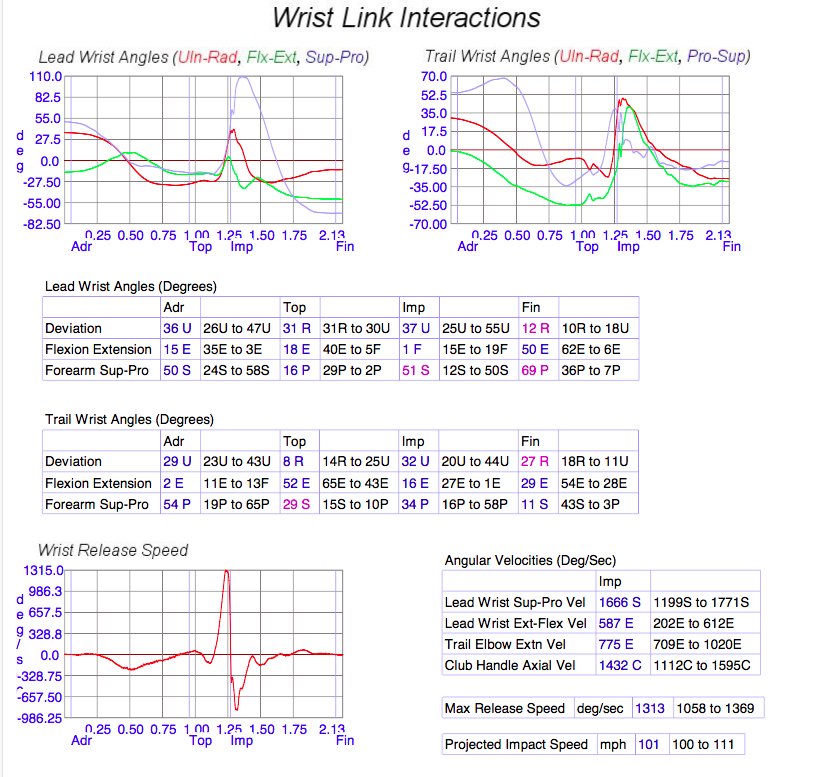 If you look at the 'Trail Wrist Angles (Degrees)' table you will note that at address the golfer is 54 degrees pronated, therefore the positive y-axis in the TPI trail wrist graph represents pronation. Further at P4 the golfer is 29 degrees supinated (below the zero line) and 34 degrees pronated at impact (above the zero line). DG ps. In the video Jon Sinclair says that when both the blue line graphs moves up that means there is supination happening. I think he's misinterpreted the trail wrist TPI graph but he's correct that both forearms are supinating just before impact. The left forearm is supinating , while the right forearm is moving to a slightly less degree of pronation (just before impact). |
|
|
|
Post by imperfectgolfer on Jun 30, 2020 9:32:24 GMT -5
DG,
I find those TPI graphs from the Sandtrap forum very convincing, which means that you are correct to state that the positive Y axis represents right forearm pronation.
That throws a "spanner in the works" when it comes to claiming that the Jon Sinclair video graph represents Trevor Immelman's swing action. According to that graph, the right forearm is 45 degrees pronated at address and 30 degrees pronated at P4. Then, it pronates 15 degrees more between P4 => P6 before gaining another 5 degrees of further pronation between P6 => P7. I cannot fathom how the right forearm can increasingly pronate between P4 => P6 if the golfer uses a right arm adduction maneuver with a pitch elbow motion. It suggests a punch elbow motion (ala "Malaska Move"), which I do not associate with a professional golfer's swing action.
I am flummoxed!
Jeff.
|
|








